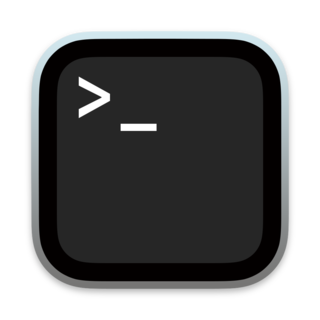Terminal (macOS)
Default macOS terminal emulator From Wikipedia, the free encyclopedia
Terminal (Terminal.app) is the terminal emulator included in the macOS operating system by Apple.[1] Terminal originated in NeXTSTEP and OPENSTEP, the predecessor operating systems of macOS.[2]
 Terminal 2.14 running the top program under macOS Sonoma | |
| Developer(s) | Apple Inc. |
|---|---|
| Initial release | March 27, 2001 |
| Stable release | 2.14 (454.1)
/ September 16, 2024 |
| Written in | Objective-C |
| Operating system | macOS |
| Platform | |
| Type | Terminal emulator |
| License | Proprietary |
| Website | support |
As a terminal emulator, the application provides text-based access to the operating system, in contrast to the mostly graphical nature of the user experience of macOS, by providing a command-line interface to the operating system when used in conjunction with a Unix shell, such as zsh (the default interactive shell since macOS Catalina[3]).[4] The user can choose other shells available with macOS, such as the KornShell, tcsh, and bash.[4][5]
The preferences dialog for Terminal.app in OS X 10.8 (Mountain Lion) and later offers choices for values of the TERM environment variable. Available options are ansi, dtterm, nsterm, rxvt, vt52, vt100, vt102, xterm, xterm-16color and xterm-256color, which differ from the OS X 10.5 (Leopard) choices by dropping the xterm-color and adding xterm-16color and xterm-256color. These settings do not alter the operation of Terminal, and the xterm settings do not match the behavior of xterm.[6]
Terminal includes several features that specifically access macOS APIs and features, such as the command mdfind which is the terminal interface of Spotlight.[7][failed verification][8][failed verification] Terminal offers a range of profiles that include custom font and coloring options, and custom profiles can be created as well.[9]
See also
References
Wikiwand - on
Seamless Wikipedia browsing. On steroids.
